A lopper sounds like . . . well, we don’t really know what it sounds like, but it doesn’t sound like a serious gardening tool. The name might seem less formal, but the tool is a great item to add to the shed. If you have trees, shrubs, vines, or other vegetation with thick branches or branches that are a bit out of reach, this is the tool for you.
You’ve almost certainly seen loppers even if you weren’t aware of the name. We’ll talk here about what to use them for and what makes for a good set of loppers. And then we’ll review our choices for the best on the market.
What To Use Loppers For
Loppers are similar to hand pruners. They’re designed to cut through stems and branches. What sets them apart, though, is that they have long handles so you can reach beyond arm’s length, whether that’s above you or in front of you.
They are also distinct in that they are a two-handed tool. The long handles open wide, so you won’t be able to squeeze them shut with just one hand.
Of course, using two hands also means you can apply more strength. So you may be able to slice through slightly thicker or tougher branches than with a one-handed tool.
Loppers can do a lot, so it can be tempting to overuse them. To keep them in good working shape, though, try to only use them as appropriate. Use hand pruners on smaller branches that are close to you. Likewise, you might be able to force loppers through a branch that’s thicker than it’s designed for. In this case, it’s best to switch to a tree saw; otherwise, you could wear out your lopper’s blades and joint.
Learn how to keep your hedges and bushes in great shape!
Types Of Loppers
There are two main classes of loppers. The type is based on the cutting mechanism.
Bypass loppers work like scissors. They have two sharpened blades that glide past each other when you squeeze the handles together. This creates a clean, easy cut. They’re best used on live wood.
Anvil loppers, on the other hand, have only one sharpened blade. The other side is wide and flat, and the sharpened blade cuts down onto it. Anvil loppers can help provide leverage for cutting tougher material. If you’re trimming back dead branches, these can be great. The mechanism does tend to crush the piece being cut, though, so it isn’t as healthy for live plants.
Get great tips for pruning a tree.
What To Look For In Loppers
There are a couple factors to consider when choosing loppers.
First, be sure you’re choosing the right tool. Most loppers measure from 28 inches to 32 inches long. They’re also rather wide. If you need to reach farther, this isn’t what you need, and you could be putting yourself in danger by overextending and risking a fall.
Different loppers can handle different widths of branches. Most have maximums of 1 ¼ to 2 inches. If your task is smaller and doesn’t require the reach, try hand pruners. If you need to cut something thicker, a saw is a better choice.
Loppers should be sturdy, especially in the pivot joint. With use, this joint will work loose, but of course, you don’t want it to do so too often.
Good balance is key to being able to use loppers effectively. The bill has to be heavy, of course, to be tough enough to do the cutting. However, it shouldn’t be so heavy that it becomes difficult to control.
Comfortable hand grips can make it easier to use the tool. You’ll want to look for a material that makes it comfortable to hold and will help keep your hands from slipping.
Finally, it goes without saying that the material your loppers are made from should be sturdy. The blades should hold an edge. The handles should be durable enough not to bend while also being light enough to handle easily.
Loppers can’t handle the size of your branches? A chainsaw might be a better choice.
Our Picks for the Best Loppers
Here are our reviews of the best loppers we’ve found on the market. We hope you find them useful!
Bypass Loppers
Fiskars 91466935j 28 Inch Bypass Lopper
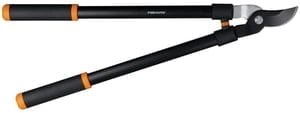
These bypass loppers measure 28 inches from tip to tip; the handle part is about 22 inches. They can cut branches up to an inch and a half thick.
One of the most unique features to these (and some other Fiskars loppers) is the “shock absorber” feature. Found right behind the joint, this is supposed to prevent the hard impact when you squeeze the loppers closed. Honestly, it wasn’t something we ever considered a problem before, but it does make a little bit of a difference in the comfort level.
The tool weighs 2.8 pounds. The handles are made of steel and the blades are hardened steel.
Fiskars offers a lifetime warranty on these.
These receive high marks for dependability and durability. We’ve heard of rare instances of failure, but most people find that they hold up to moderate to heavy use for years.
Tabor Tools Gl16 Classic Bypass Lopper
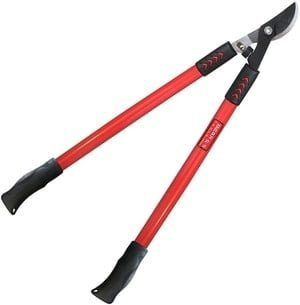
This product from Tabor Tools offers a great way to cut through branches up to an inch and a quarter thick. They measure 28 inches long overall, with 22-inch handles.
The tool weighs 2.9 pounds. The handles are metal and the blades are hardened metal.
There are comfortable rubber hand grips that make these comfortable to use. They also have a bumper to prevent sudden banging as you close them.
The cutting action is nice and smooth, so you won’t tire out too quickly. They’re easy to use and seem to hold their edge well under normal use. Like most other loppers, the blades have a non-stick coating that does seem to help prevent the buildup of “gunk.”
The warranty is for 12 months.
Fiskars 32-inch Powergear Bypass Lopper

We did a double-take when we saw these, to be honest. Yes, they are bypass loppers. But they definitely look like anvil loppers at first glance.
The Powergear series from Fiskars does have this unique look, though, because of the special gear system they use. They do make cutting easier – you need less force to make the cuts, and that’s what makes it possible to cut branches up to 2 inches thick. Fiskars claims they have “3 times” the cutting power. We don’t have the instruments to confirm that, but they’re definitely more powerful than traditional loppers.
The tool length is 32 inches. The handles themselves measure 28.5 inches. The unit weighs 2.75 pounds – slightly less than the other bypass loppers we’ve reviewed here, despite being a larger unit. Fiskars says the gear system along with using fiberglass composite in the handles allows for this.
They may have problems with thicker, harder wood. But for softwoods or branches of a smaller diameter (around an inch) they are excellent!
Again, Fiskars offers a lifetime warranty.
Anvil Loppers
Spear & Jackson 8290RS Razorsharp Heavy Duty Telescopic Ratchet Anvil Loppers
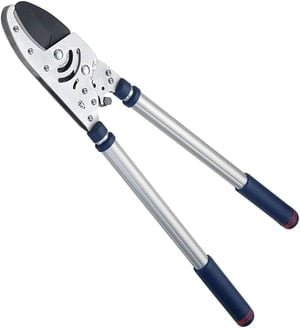
Spear & Jackson’s 8290RS Telescopic Anvil Loppers do a great job cutting and easily adapt to a variety of lengths.
The blades are coated carbon steel, which means they’ll stay sharp even with prolonged use.
A 2-inch branch can fit in the bill, although it can be tough to cut. For pieces one to 1.5 inches across, you should be fine.
The handles are aluminum. At their shortest, they measure 15.75”. Fully extended, they reach 31.5”. That’s a great range for doing a wide variety of jobs. They lock in place with a simple twist of the handle.
All of these features do add to the price, despite the aluminum. These weigh about 4.17 pounds. That can make them tiring to use over an extended period.
The hand grips are reasonably comfortable and do protect against slipping.
These carry a ten-year guarantee.
Tabor Tools Gg12 Compound Action Anvil Lopper
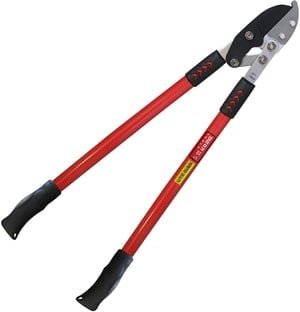
These Tabor Tools anvil loppers offer a couple great features that will make them a favorite.
The compound gear makes them easy to use; even thicker branches are relatively easy to cut through. They can handle pieces up to 1.5 inches without much problem. The manufacturer does say they can handle 2 inches, but a lot of people report problems with pieces that big.
These loppers measure 30 inches overall, although there is a more compact, 22-inch version available, too. They are a bit heavier than other models, weighing in at 3.7 pounds.
This tool is great if you’re cutting through thick, dead wood. The extra power you get from the compound action is a huge help. On the other hand, they’re pretty heavy. You’ll be glad you’re cutting more easily because you won’t want to have to carry these for extended periods.
The warranty is for one year.
Tabor Tools Gb19 Compound Action Anvil Mini Lopper
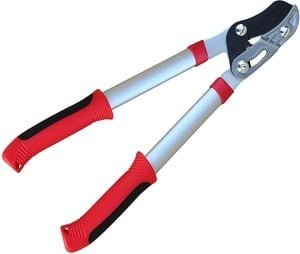
If you need a more compact lopper, these might be for you. They help fill a gap between hand pruners and regularly sized loppers. They measure 19” long and weigh only 1.75 pounds.
These are good tools for cutting thicker branches or when you have to reach just a little bit.
You can get a branch an inch and a half thick into the bill of these loppers. They cut well through most woods up to about an inch. You can get through thicker pieces but it does take effort.
The handles are aluminum and do have comfortable rubber hand grips on them. The grips are reasonably formed for the average hand, so they’re somewhat ergonomic.
There’s a one-year warranty on these.
Conclusion
Loppers are an important tool for your garden. They’ll help you cut through branches that are out of reach or too thick for your hand pruners. A good set of loppers will hold up for years and make trimming tree branches, bushes, and vines an easier task.










